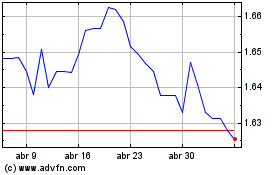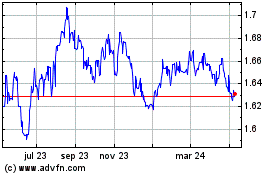Euro Falls Amid Risk Aversion
25 Mayo 2017 - 4:11AM
RTTF2
The euro slipped against its major counterparts in the European
session on Thursday amid risk aversion, as oil prices fell after
news that the OPEC members agreed for a nine-month extension to the
oil production curbs, lacking any surprises for deeper cuts.
Oil prices retreated after Saudi Arabia's oil minister Khalid
al-Falih rejected the notion of deeper cuts to oil production at
the ongoing meeting of OPEC and 11 non-OPEC countries in
Vienna.
The agreement to extend output cuts by another nine months
failed to inspire market participants, who had been expecting
deeper cuts. A formal announcement is expected after 11 am Eastern
Time.
Investors digested Fed minutes that showed the likelihood of
another hike in June, but conditional on recent economic softness
proving transitory. Policy makers also discussed scaling back their
$4 trillion-plus holdings of mortgage-backed bonds and longer-term
U.S. government bonds.
Final data from the statistical office INE showed that Spain's
economic growth improved slightly, as estimated, in the first
quarter.
Gross domestic product grew 0.8 percent sequentially in the
first quarter, in line with preliminary estimate. The pace of
expansion accelerated from 0.7 percent seen in the fourth quarter
of 2016.
The euro was higher against its major rivals in the Asian
session.
The euro edged down to 1.1201 against the greenback, after
having advanced to a 2-day high of 1.1250 at 4:30 am ET. The euro
is likely to target 1.11 as the next support level.
Reversing from an early 2-day high of 0.8667 against the pound,
the euro eased to 0.8646. If the euro-pound pair extends fall, it
may target 0.84 as the next support level.
The second estimate from the Office for National Statistics
showed that the UK economy expanded less than previously estimated
in the first quarter.
Gross domestic product grew 0.2 percent sequentially in the
first quarter instead of 0.3 percent estimated on April 28.
The euro weakened to a 3-day low of 1.0892 against the franc,
off its early high of 1.0929. Continuation of the euro's downtrend
may see it challenging support around the 1.07 area.
The euro, having advanced to a 9-day high of 125.81 against the
yen at 3:45 am ET, reversed direction and edged down to 125.22. The
next possible support for the euro-yen pair is seen around the
122.5 area. The euro eased back to 1.5042 against the loonie,
1.5926 against the kiwi and 1.4996 against the aussie, from its
early high of 1.5114 and multi-day highs of 1.6005 and
1.5063,respectively. Further weakness may take the euro to support
levels of around 1.48 against the loonie, 1.55 against the kiwi and
1.48 against the aussie.
Looking ahead, at 10:00 am ET, the Federal Reserve Governor Lael
Brainard participates in a panel discussion titled "A Conversation
with former Treasury Under Secretaries for International Affairs,"
in Washington DC.
At 1:00 pm ET, the European Central Bank Vice President Vitor
Constancio gives lecture at Instituto Superior de Economia e Gestao
(ISEG) Master in Monetary and Financial Economics in Lisbon,
Portugal.
Euro vs AUD (FX:EURAUD)
Gráfica de Divisa
De Mar 2024 a Abr 2024

Euro vs AUD (FX:EURAUD)
Gráfica de Divisa
De Abr 2023 a Abr 2024
